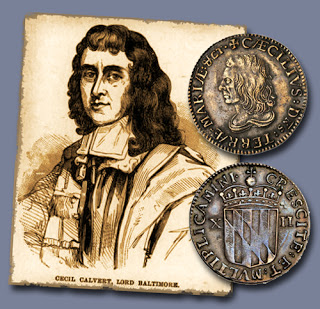
The Roper-Royse Lord Baltimore shilling is a superb example of an elusive and historically distinctive issue, coined for Cecil Calvert for circulation in his proprietary colony of Maryland. Golden toning graces the obverse, with fainter hues of violet and blue, while those shades dominate the reverse. Some luster persists; the surfaces are a bit dusty, yet are very appealing overall. No damage or heavy marks are seen, only the most inconsequential hairlines, shallow planchet flaw under ES of CRESCUNT and another below X of the denomination. This example is nicely original, boldly detailed and nearly ideally centered with a full complement of denticles framing the obverse and the top half of the reverse. The usual die damage from a cock-eyed clash is seen on the right side of Calvert’s arms on the reverse.
The terms of Calvert’s grant called for him to be guaranteed all rights enjoyed by the Bishop of Durham, who had issued coins in his own name during the Middle Ages. Thus, Calvert had shillings, sixpences, groats, and copper pennies (or denariums) coined bearing his bust and arms, and passed local ordinances in Maryland calling for their mandatory circulation. He ran afoul of British authorities, who frowned on him exporting silver from the mother country, no matter what the terms of his claim may have been. Despite his legal troubles, coins of every denomination reached Maryland and began circulating there in the early 1660s.
Today, most survivors of this denomination are in poor condition, often holed and plugged after use in jewelry, badly polished, well worn, or a combination of the above. While sixpence often survive in decent grade, thanks in part to a hoard of about 20 pieces located in England in the last decade, the shillings rarely fared so well. While a few high grade pieces exist today, more than one show what may be charitably called negative eye appeal — the Ford piece showed some fairly substantial pin scratches. The Jim Jones specimen, sold in our March 2012 sale, was a nicely balanced coin in a PCGS EF-40 holder but was not as sharp, flashy, or well-centered as this piece. This is the only PCGS AU-50+ certified, and one of only two Maryland shillings with a "+" grade. The Roper provenance usually accompanies coins of lovely quality and eye appeal, and this coin is no exception.





